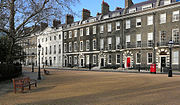Brunswick Square
51°31′28″N 0°07′18″W / 51.5244°N 0.1218°W

Brunswick Square is a 3-acre (1.2 ha) public garden and ancillary streets along two of its sides in

Layout

Bloomsbury is notable for its garden squares,
- Protection
Brunswick Square and Mecklenburgh Square and Coram's Fields are jointly listed Grade II on the
History
What is now the square (apart from the longer of the two roads bounding it and sharing in its name which is older) including the nearer part of buildings facing it was originally part of the grounds of the Foundling Hospital. It was planned to be leased for housebuilding, along with Mecklenburgh Square, to raise funds for the hospital in 1790. Brunswick Square, named after Caroline of Brunswick, was finished first, being built by James Burton in 1795–1802; none of the original houses remain.[3]
The bronze sculpture of a child's mitten, by Tracey Emin, sits on top of one of the railings outside the Foundling Museum.[4]
In literature, arts and the media
In Jane Austen's Emma, John and Isabella Knightley live in Brunswick Square.
In William Makepeace Thackeray's Vanity Fair, Mr. Osborne lives in Brunswick Square.
Notable residents
John Ruskin was born at 54 Hunter Street, Brunswick Square in 1819.
The Minerva Club was founded here by Dr Elizabeth Knight and Alice Green in 1920. The club was used for Women's Freedom League meetings and as a hostel for suffrage activists and fund-raising annual birthday parties[5] for Charlotte Despard. Despard travelled from Ireland each year to attend.[6]
The writer
References
- ^ Guide to London Squares Archived 2007-10-12 at the Wayback Machine. Retrieved 8 March 2007.
- ^ Historic England, "Coram's Fields, and Brunswick and Mecklenburgh Squares (1000212)", National Heritage List for England, retrieved 12 November 2017
- ^ UCL Bloomsbury Project: Brunswick Square
- ISBN 978-1-84403-955-5.
- ^ "The Minerva Café". libcom.org. Retrieved 26 December 2018.
- doi:10.1093/ref:odnb/63885. (Subscription or UK public library membershiprequired.)
- ISBN 978-0-521-83475-9

